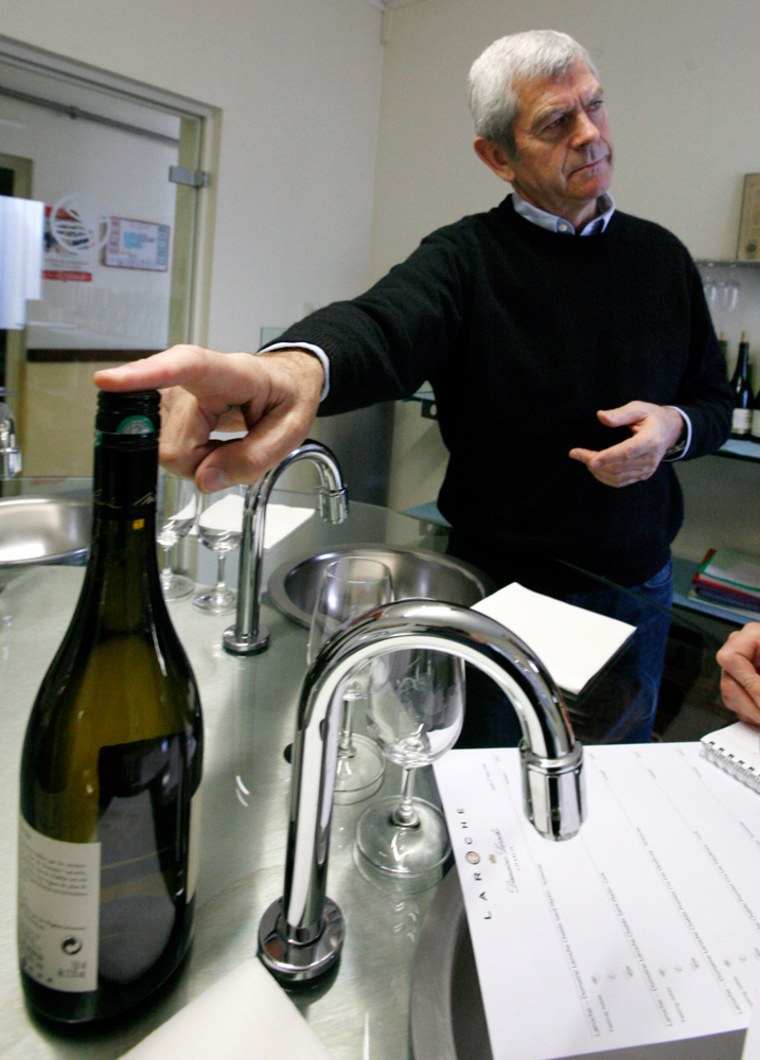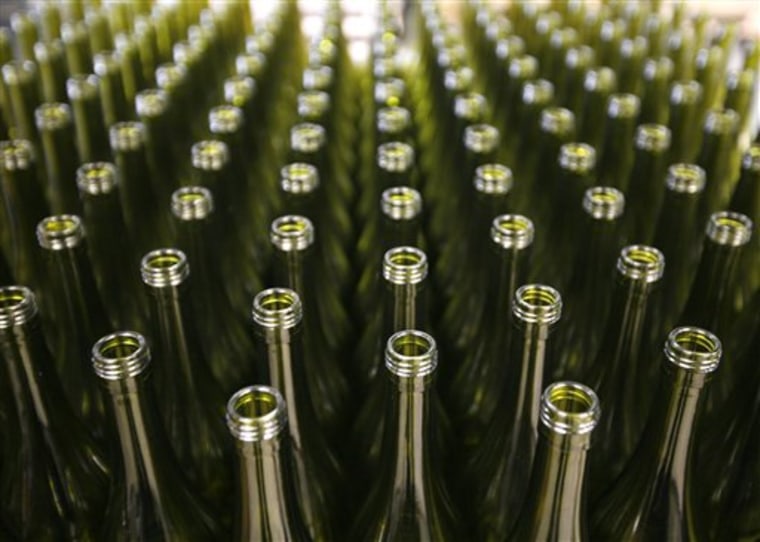Fine French wine with a screw top?
At La Cote Saint Jacques restaurant, a Michelin three-star temple of gastronomy in the Burgundy region, chief sommelier Arnaud Laplanche isn't ashamed to give it a try.
He's part of a quiet revolution sweeping the French wine business, the world's largest and fighting to stay that way.
France's goal: to hold off New World winemakers that have wooed wine lovers and gained market share with jazzy marketing campaigns, helpful information on what's inside the bottle, and quality assurances that some French wines lacked.
Screw tops, boxed wines, colorful easy-to-understand labels and sophisticated marketing — innovations pioneered by countries like Australia and South Africa — are making inroads in tradition-bound France, even if many still sneer.
"We didn't see the danger coming from the New World — where competition came with a completely new approach to wine making," said Renaud Gaillard, deputy head of the French Federation of Wine and Spirits Exporters.
"Finally we understood we had to change not only production but also the way the product is presented. We had to make the buying process easier."

La Cote Saint Jacques serves Chablis Grand Cru Reserve de l'Obedience at $326 with a screw-top cap. It is the most expensive wine made in the Laroche vineyards in nearby Chablis and isn't available with a cork.
Laplanche said he was initially reluctant to give up the showman part of his job — uncorking a bottle — but was won over by the taste and prospect of no more wines that are spoiled by premature oxidization — "corked," in wine parlance.
"It takes away the charm of opening the bottle, smelling the cork," he said. "But it's very frustrating when a wine is corked. Screw tops are a more sure way of preserving the wine."
The screw-top shake-up was inspired as much by practical considerations as by consumer preference. Increased demand on cork suppliers has forced manufacturers to harvest immature cork, which some suspect causes the oxidization.
While some argue that wines requiring more oxygen as they age require an old-fashioned cork, many winemakers are turning to more reliable seals for all but their heaviest reds.
Back in 2001, a bleak report on the state of the French wine industry written for the Agriculture Ministry urged winemakers to lose the snobbish attitude and be more attentive to consumers. The 80-page document included a five-point lesson in marketing for beginners: product, price, promotion, packaging and place.
"A logic of marketing didn't exist before," said Gaillard.
"We started talking about marketing of the offer and marketing of the demand — terms which are quite unbelievable for wine — but we now know what they mean."
Since then French producers have taken steps to make their wine more accessible.
Bottles are starting to look different. Some old-fashioned labels with grainy pictures of wine chateaux are going out, replaced with bright colors, brand names and innovations once unheard of such as printing directly onto the bottle.
Small producers are combining to market their wines. The pink butterfly embedded in the bottle of Fruite Catalan has helped make Vignerons Catalans en Roussillon — three groups of producers who together created the brand — an export hit. Their wine also is winning awards at home.
Crucially, grape varieties are making regular appearances on wine labels as French producers accept that most international consumers are more interested in the grapes, rather than what estates or vineyards they're from.
This is helping France's wine and spirit industry reverse decades of decline. Last year the industry exported nearly $15 billion worth abroad, a record and an increase of nearly 7 percent year-on-year.
Success stories include "French rabbit," the brand name for wines cultivated from pinot noir, chardonnay, cabernet sauvignon and merlot grapes in the Languedoc-Roussillon region of southern France.
The vintage-dated, appellation-specific wine comes in bright-orange cartons with screw-top closures — and the 250 milliliter version even comes with a straw.
Introduced in 2005 on the Canadian market in both glass bottles and cartons, the carton version was within a month outselling glass bottles by 21 times.
However, it's the use of screw-tops for quality wines that have come to symbolize the changes taking place in the ultra-conservative world of French wines.
Michel Laroche, whose family has been tending Chablis vineyards for five generations, began experimenting with them in 2001 after a harvest of bad quality corks. A year later he became the first French producer to offer screw tops on grand cru wines — a label reserved for the best vineyards.
He says screw tops are a better solution than synthetic corks, which sometimes leave air pockets or gaps and can be hard to remove.
As well as cutting out returns of corked wine, the switch has been good for business, he said. In Quebec, Laroche introduced screw tops in 2004 and boosted sales by 15 percent in one year.
Wine lovers were won over when they saw quality wines being sold with a screw top.
"If you want people to believe you then you have to start with the prestige products," Laroche said.
The oenologue-turned-entrepreneur, who has added vineyards in southern France, South Africa and Chile to the family acreage, now sells 62 percent of his wines with screw tops. But in France, only 14 percent of Laroche wines don't have corks.
Other winemakers are following, Gaillard says, particularly with wines destined for export.
In Britain, where he says consumers lack a "cultural predisposition to wine" and are fond of wine "novelties," supermarket giant Tesco PLC now sells 50 percent of its wines with a screw top, including a third of its French offerings.
French consumers are more resistant.
"Screw tops are extremely suspect," said theater director Jean Manifacher, 44, as he shopped in Paris wine store Cave des Cascades.
"It's fast food wine. I'm in no rush to open the bottle. I like to take my time, savor the experience, enjoy the sound of the removing of the cork from the bottle."
Laroche said he knew there "would be a lot of resistance in France." As he watched green bottles full of white wine line up to be fitted with a black cap, he sighed: "It's a problem of culture and tradition."
Yet in France, tradition is not usually regarded as a problem. Winemakers have long relied on it to sell their wines, particularly in regions widely recognized and popular overseas such as Champagne and Bordeaux.
Conde says the younger generation of winemakers in lesser known regions are starting to shake things up a little — because they have no option.
Barbara Glunz, proprietor of the 120-year-old House of Glunz, Chicago's oldest continuing wine-seller which has been in her family for five generations, said the French wine industry — which provides the bulk of her stocks — has made great strides in recent years.
Glunz sells no box wine, but says she's definitely a fan of screw-top bottles because they prevent the spoilage of wine.
Bob Prewitt, a 60-year-old advertising executive from Pennington, N.J., agrees.
"I actually once opened a $2,000 bottle of wine that was corked," he said. "Now I'm a huge fan of screw caps."
Laroche's wife, Gwenael, is taking the French wine revolution to the new frontiers of the business, like Vietnam, where she has recently been preaching the screw top's virtues.
"If you over-intellectualize the wine, you scare people off," she said, at a trendy wine bar in Chablis, which she designed with her husband.
Gesturing to a 1,000-year-old grain mill opposite, she said: "Here you can't get away from the 12th century — when the monks planted the first Chablis vines. You can't escape history, but you don't have to live in the past."
